SENSORY DELIGHTS, NOW AND FUTURE
A Scented Wave
For the past couple of weeks, every time I walk upstairs to my home office, a sweet aroma hits me like a wave a few steps before I reach the top stair. This wave pulls me forward, a room and a half away, to the Meyer lemon plant sitting in my office’s sunny, south-facing window.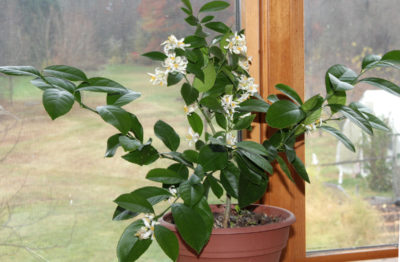
The wave began when only a single Meyer lemon flower had opened. Now, the plant, only a foot and a half high, is decked out with more than 20 flowers.
This “tree” started life as a cutting I took from a friend’s old tree that anyway needed some pruning. With their bottom leaves stripped off, the 6 inch long stems rooted reliably in a few weeks after their bottom portions were plunged into a moist mix of equal parts peat and perlite, and transpiration was reduced with a clear plastic overhead. Bright, but indirect, light allowed for photosynthesis without cooking the plants in their “mini-greenhouse.”
My most important job now is to keep an eye out for scale insects, which show up as either brown bumps (armored scale) or cottony tufts (cottony cushion scale) on leaves and stems. Rubbing off these insects or dabbing them with a Q-tip soaked in alcohol deals with them unless the population gets out of hand. Repeated sprays with horticultural oil can be the next line of defense.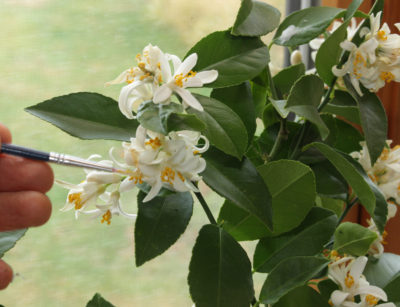
Every couple of days I pick up the artist’s brush lying next to the potted plant, and dab it on the tips of some of the flowers. I’m not painting; I’m picking up the yellow pollen from each flower’s male anthers and dusting it onto each flower’s, and neighboring flower’s, female stigmas.
A good proportion of those pollinated flowers should go on to provide the next treat from Meyer lemon, fruit, which this plant usually bears prolifically. Meyer lemon is actually a hybrid of lemon and sweet orange, with both parents reflected in the flavor. A final plus for this plant is, in contrast to many other citrus plants, is that its stems lack thorns.
Another Fig Option
Greenhouse figs still bear fruit; with low light and cool temperatures, they’re not worth eating. I did recently harvest a few figs from a Kadota fig plant that had been planted outdoors.
“Had been planted outdoors?” So where is it now? It’s still outdoors, but not planted. It’s in a pot. Like my few other potted figs, the potted Kadota plant will move down to the basement before temperatures drop below 20°F.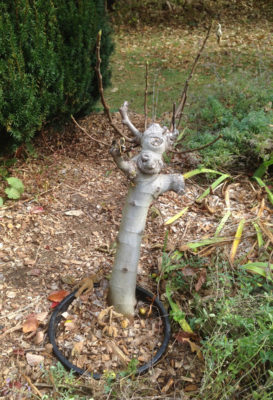
Unlike my other potted figs, the Kadota plant did not require daily watering all summer. Or yearly root pruning and repotting to give the roots new room to grow and explore. The reason is because Kadota is in an 18” diameter plastic pot with some holes I drilled in its side. In spring, I sunk the pot up to its rim into a waiting hole in a bed on the sunny, south side of my house. The plant’s roots wandered outside the pot into the surrounding soil through the existing opening in the bottom of the pot, as well as through the side openings. Once outside the pot, roots were able to fend for themselves garnering water and nutrients for the small tree.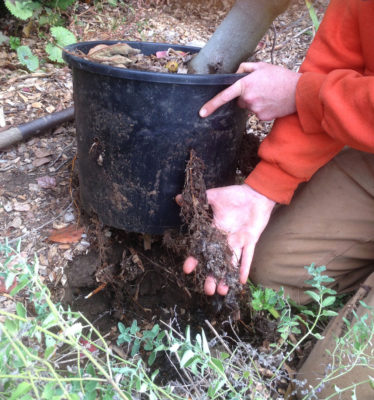
Kadota, like many other fig varieties (but few other kinds of fruits), bears fruit on new shoots. Very convenient. Rather than having to squeeze spreading limbs down my narrow basement stairs, I can cut back all the stems rather drastically, which also has the benefit of stimulating vigorous, new shoots at the cut stub, new shoots that will bear fruit next year. Not too drastically, though, or too long a time might be required for the fruit to develop and ripen. And Kadota is already a late ripening variety.
Of all my figs, Kadota is my favorite, both for its almost chewy skin and the rich, sweet flavor lying within. Even those recently harvested ones.
Comely, Fragrant, and Poisonous
Another sensory treat slated for winter comes compliments of Angels’ Trumpets (Brugmansia spp.). The flowers of these poisonous(!), subtropical trees are giant, 6 inch long trumpets in pale colors and from which wafts a delicious aroma, especially at night. These subtropical plants can grow into trees but are easily kept much small, in pots, in cold climates.
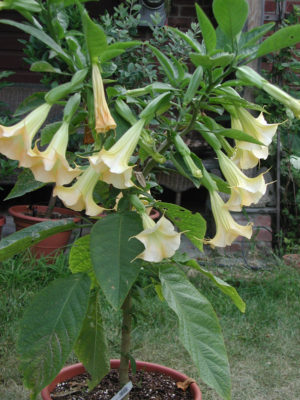
Angels Trumpets, in past years
I neglected my plant all summer and on into fall; when I retrieved it to protect it from coldest nights, it was just about leafless and ready for the compost pile. Then I noticed some small leaves beginning to develop along its almost bare stems. And some stems had the beginnings of flowers on them.
So I brought Angels’ Trumpet indoors, next to a sunny window (and next to the Meyer lemon). It looks sad now but should revive and, judging from my previous experiences with this plant, flower well most of winter. In summer, with long days, it takes a rest from flowering — which is why I ignored the plant.

